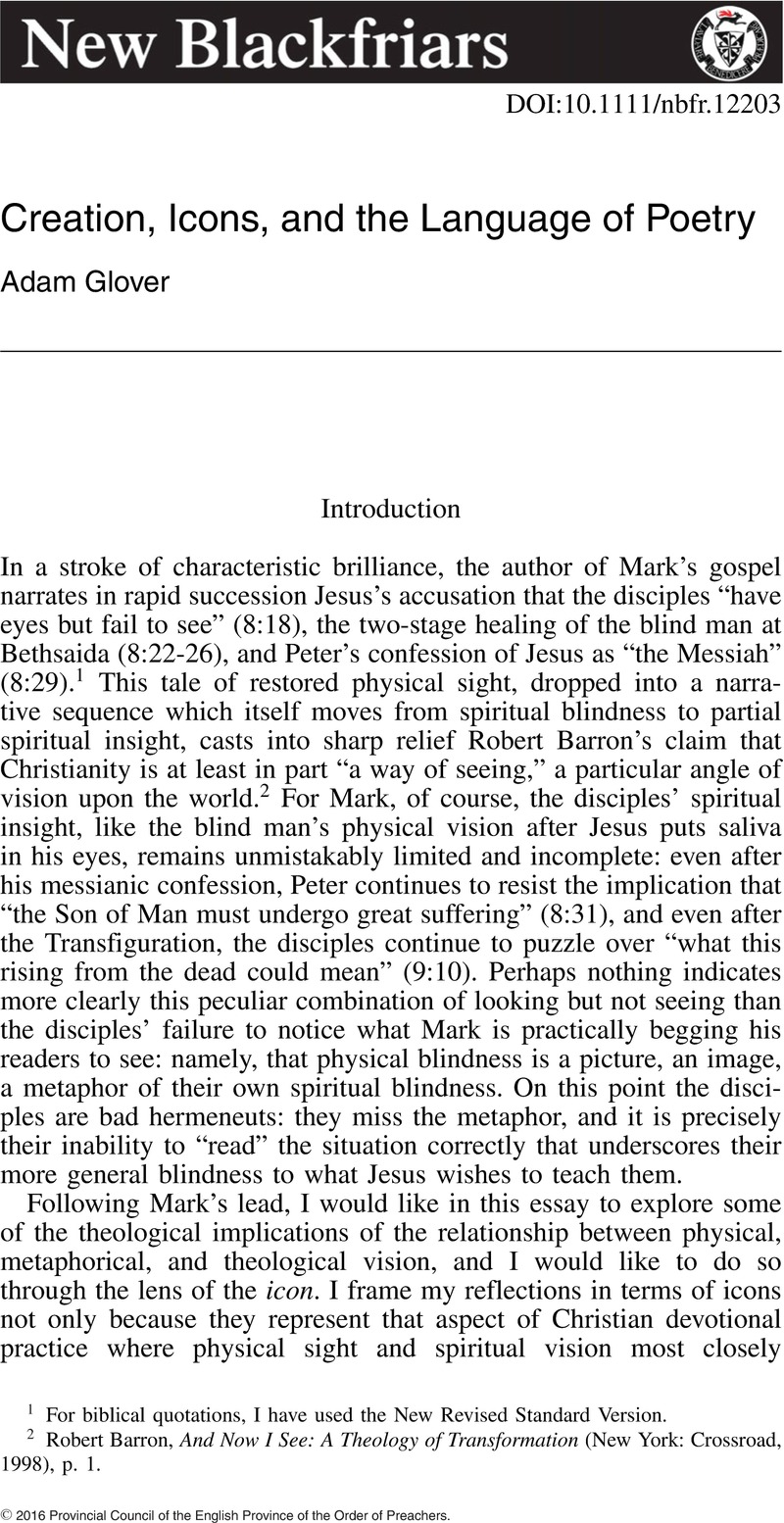Published online by Cambridge University Press: 01 January 2024

1 For biblical quotations, I have used the New Revised Standard Version.
2 Barron, Robert, And Now I See: A Theology of Transformation (New York: Crossroad, 1998), p. 1Google Scholar.
3 De imaginibus, I, 9. I have taken the English translation from St John Damascene on Holy Images, trans. Allies, Mary H. (London: Thomas Baker, 1898), p. 10Google Scholar.
4 De Imaginibus, I, 4.
5 De imaginibus I, 4-5, 9; St John Damascene on Holy Images, p. 5.
6 Summa theologiae, IIa, q. 94, a. 1. For translations, I have generally followed Aquinas, Thomas, Summa theologiae (Cambridge: Blackfriars, 1964-1981)Google Scholar.
7 Marion, , God without Being: Hors-texte, trans. Carlson, Thomas A. (Chicago: Chicago University Press, 1991), p. 14Google Scholar.
8 I borrow this illustration from Rea, Michael, “The Trinity,” in Flint, Thomas P. and Rea, Michael, eds., The Oxford Handbook of Philosophical Theology (Oxford: Oxford University Press, 2009), p. 407Google Scholar.
9 Marion, God without Being, p. 9.
10 Marion, God without Being, p. 21.
11 Marion, God without Being, pp. 17-18.
12 I borrow the concept of “ double vision ” from Guite, Malcolm, Faith, Hope, and Poetry: Theology and the Poetic Imagination (Burlington, VT: Ashgate, 2010), p. 104Google Scholar.
13 Marion, God without Being, p. 22.
14 Quintilian, Institutio, 8.6.19.
15 Cicero, De oratore, 3.40.161. English translation from Cicero on Oratory and Orators, trans. Watson, J.S. (London: Bell and Daldy, 1871), p. 378Google Scholar.
16 Aristotle, Poetics, 1459a.
17 Homer, , Iliad, vol. 1, trans. Murray, A.T. and Wyatt, William F. (Cambridge, Mass.: Harvard University Press, 1999)Google Scholar, III: 154-158 (translation modified).
18 Aristotle, Rhetoric, 3.4.
19 Aristotle, Poetics, 1459a.
20 See note 12.
21 De imaginibus, III.21; St John Damascene on Holy Images, p. 96.
22 Aquinas, Summa theologiae, Ia, q. 4, a. 3.
23 Gilson, , L'esprit de la philosophie médiévale (Paris: J. Vrin, 1969), pp. 97-98Google Scholar.
24 Przywara, Erich, Analogia Entis: Metaphysics: Original Structure and Universal Rhythm, trans. Betz, John R. and Hart, David Bentley (Grand Rapids: Eerdmans, 2014), p. 233Google Scholar
25 Gilson, L'esprit, p. 98. See also the excellent discussion in Betz, John, “Beyond the Sublime: The Aesthetics of the Analogy of Being (Part Two),” Modern Theology 22.1 (2006): pp. 1-50CrossRefGoogle Scholar.
26 Carrasco, Iván, “Cántico cósmico de Cardenal: un texto interdisciplinario,” Estudios filológicos 39 (2004), paragraph 13Google Scholar.
27 Cardenal, Ernesto, Cántico cósmico, (Madrid: Editorial Trotta, 1993), p. 19Google Scholar. The translation is mine. Subsequent references to this text will be given parenthetically.
28 Aquinas, Summa theologiae, Ia, q. 42, a. 1 ad 1. See also Brock, Stephen L., “Causality and Necessity in Aquinas,” Quaestio 2 (2002): pp. 217-240CrossRefGoogle Scholar.
29 Huidobro, Vicente, “El creacionismo,” in Nelson Osorio T., , ed., Manifiestos, proclamas y polémicas de la vanguardia literaria hispanoamericana (Caracas: Biblioteca Ayacucho, 1988), p. 168Google Scholar.
30 Huidobro, Vicente, Altazor, trans. Weinberger, Eliot (Middletown, CT: Wesleyan University Press, 2003), p. 71Google Scholar.
31 Richards, I.A., The Philosophy of Rhetoric (London: Oxford University Press, 1936), pp. 90-97Google Scholar.
32 Summa theologiae, Ia, q. 13, a. 2.
33 Turner, Faith, Reason, and the Existence of God, p. 211.
34 I borrow these examples from Turner, Faith, Reason, and the Existence of God, p. 235.